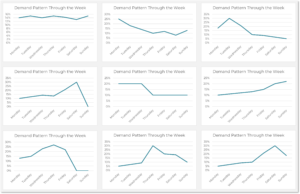Demand forecasting is often done in planning buckets such as months or weeks. But what about the pattern of demand inside a period? Do you keep track of the sales patterns inside your forecasting period? Is your demand front-loaded inside your planning period? Or backloaded? Or flat? Does it resemble a camel’s hump in the middle of the week? Or does it gently slope up from the front of the period to the middle and then slowly decrease?
Whatever pattern it is, a demand planner should strive to understand it. And these patterns would be different for different combinations. One could argue that the number of patterns equal the number of forecasting combinations. However, it is important to group them for planning purposes. Perhaps there are 6-8-10 unique pattern groupings that a business could track. These can be given recognizable names that can then be added as members of a dependent attribute to the planning database.
So how can this be useful? Say you have a forecast of 3,000 and you already have open orders worth 3,000 units in your ERP system. And it is the 5th day of the month. Should you panic and make (or buy) more? Or relax because you know this is a combination that gets most of the demand at the beginning of the period? If it is a combination that usually has demand that is front-loaded in the period, then all is good. Otherwise, one may want to check the inventory. If no inventory is available, one would think about any mitigation measures needed including breaking into the schedule and making more if there is no inventory available.
Further, it is well known that the demand is needed in granular buckets for execution. For example, by day. However, there is typically too much noise in the data to develop the forecast in daily buckets. This technique of figuring out patterns inside a period allows a planner to tackle this important problem in two steps:
- Develop a forecast in weekly or monthly buckets
- Use previously calculated day-by-day ratios to break demand for executions steps
One can automate this type of analysis and create meaningful, actionable alerts in any modern planning system.
So, do you keep track of the sales patterns inside your planning periods? If yes, how do you use this information?






